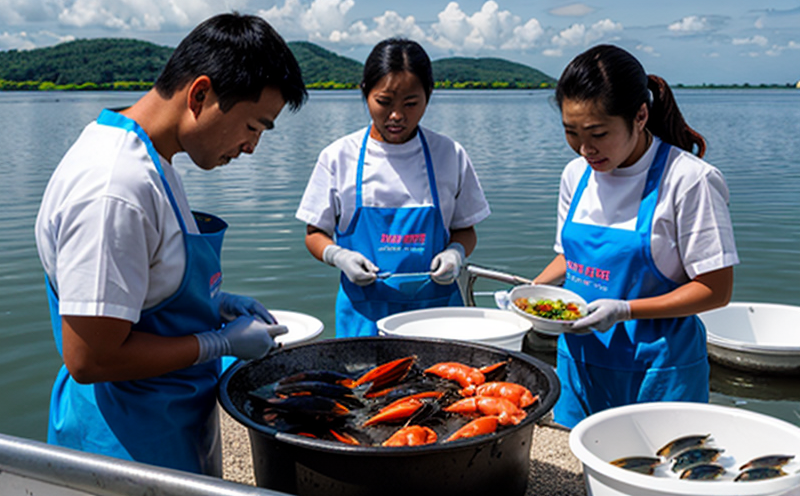ISO 29201 Veterinary Drug Residue Detection in Fish
The detection of veterinary drug residues (VDRs) in fish is a critical aspect of ensuring food safety and regulatory compliance. The ISO 29201 standard provides a harmonized approach to the analysis of VDRs in aquatic products, which is essential for protecting public health from potential adverse effects of excessive drug residues.
The standard covers various aspects including sample preparation, extraction methods, clean-up procedures, detection techniques, and data interpretation. By adhering to ISO 29201, laboratories can ensure consistent and reliable results that meet global regulatory requirements.
Our laboratory employs advanced analytical equipment such as Liquid Chromatography-Mass Spectrometry (LC-MS/MS) for accurate quantification of VDRs in fish tissues. This method allows for the simultaneous analysis of multiple drugs at trace levels, providing comprehensive coverage of potential contaminants.
The process begins with proper sample collection and preservation to maintain integrity throughout analysis. Specimens are then processed according to standardized procedures outlined in ISO 29201 before undergoing extraction using solvent-based techniques like QuEChERS (Quick, Easy, Cheap, Effective, Rugged, Safe).
Once extracted, the samples undergo purification steps designed to eliminate interfering compounds prior to analysis. Finally, LC-MS/MS is used to identify and quantify drug residues present in the sample.
Results are reported according to ISO 29201 guidelines, ensuring that they are both accurate and actionable for stakeholders involved in seafood production and distribution.
Scope and Methodology
| Aspect | Description |
|---|---|
| Sample Preparation | Involves cleaning, slicing, and homogenizing fish tissue to obtain representative samples. |
| Extraction Method | Uses QuEChERS technique for efficient removal of unwanted substances from the matrix. |
| Cleanup Procedure | Incorporates solid phase extraction cartridges to further refine extracted solutions. |
| Detection Technique | Liquid Chromatography-Mass Spectrometry (LC-MS/MS) for precise identification and quantification of VDRs. |
| Aspect | Description |
|---|---|
| Data Interpretation | Statistical analysis ensures robust interpretation of results, supporting regulatory compliance. |
| Reporting Standards | Follows ISO 29201 for clarity and consistency in presenting findings. |
| Certification Processes | Incorporates quality control measures to ensure reliability across all stages of testing. |
| Validation Protocols | Ensures that the analytical methods used meet stringent performance criteria. |
Benefits
The implementation of ISO 29201 veterinary drug residue detection brings numerous advantages to stakeholders within the seafood industry:
Enhanced food safety by eliminating harmful residues from entering the market.
Improved regulatory compliance reducing risks associated with non-compliance penalties.
Increased consumer trust fostering a positive reputation for brands adhering to international standards.
Supports sustainable practices promoting responsible use of veterinary drugs in aquaculture operations.
Facilitates easier trade by ensuring consistency with global regulatory frameworks.
Promotes research and development through reliable data collection and analysis.
In summary, adherence to ISO 29201 ensures that seafood products meet the highest standards of quality and safety, thereby safeguarding both human health and environmental sustainability.
Competitive Advantage and Market Impact
Broadens market access by meeting stringent international regulatory requirements.
Attracts discerning consumers seeking assurance of safe seafood products.
Positions the laboratory as a leader in food safety technology, enhancing brand reputation.
Facilitates partnerships with key players in the aquaculture and pharmaceutical industries.
Provides valuable insights into emerging trends and best practices within the sector.
By leveraging ISO 29201, our laboratory offers a robust service that contributes significantly to the competitive landscape of seafood testing.





